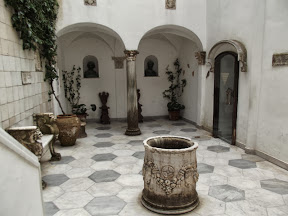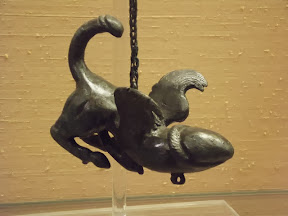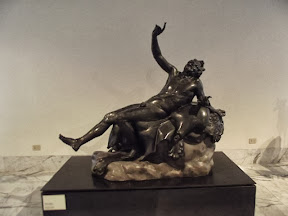Saturday 19th October
Goodness, it will be hard to choose photographs to post today, I have so many beautiful ones I have no idea how I can choose between them!
It seemed silly to be on Sorrento without going to Capri, and as Saturday was a fine day with little wind, it seemed a good day to go. It's quite a walk down to the Marina in Sorrento, as the town is built quite high above the sea, on cliffs. We walked down an awful lot of steps to the port, and I really wasn't looking forward to having to climb them again at the end of the day. We bought tickets for the Jetboat, which isn't cheap - just over €34 for a return ticket. It's €3 more if you buy two single tickets rather than a return, but if you buy a return, they specify a particular sailing, you get no choice. Fortunately, as it's low season, they aren't rigid about making you keep to your time - I daresay in the summer when it's crowded, you are obliged to return when they say. The number of seats on the boat is limited - and, unlike the bus, you can't stand.
The trip to Capri took about 35 minutes - it was a bit quicker on the way back. We took photos through the boat window as we approached the island, but as the windows were dirty, the photos are a bit blotchy.

This is one of the better ones, and shows the towering limestone cliffs which make up the island. It's another place where very little is flat. We landed at the Marina Grande, where all the boats arrive. Capri town is 150 metres above the port, and you can ascend by funicular, taxi or bus if you think the walk up the 300 steps is too much. We ascended by bus, as we had decided that, our time on the island being short, we would take a tour.
The little bus drove us through Capri and then towards Anacapri. which is 150 metres higher. Our guide, Luigi, told us that the word 'Ana' comes from a Greek word meaning 'above' - so it's just the town of 'Above Capri'.
The first people to arrive in Capri were the Phoenicians and Luigi told us they built the steps between Capri and Anacapri which, until the 20th century, remained the usual way for people to travel between Capri and Anacapri. I seem to remember, from reading 'The Story of San Michelle' about 50 years ago that Axel Munthe did the journey on a donkey. Perhaps that's how some of the Romans did it too - I can't imagine fat Roman senators obliged to visit the Emperor Tiberius having to walk up all those steps, I seem to remember reading there are hundreds of them. Lungi showed us the Phoenician steps as we drove past, but I wasn't quick enough to photograph them - it's the old story of narrow roads with nowhere for the bus to pull in.
We continued on, up little winding roads with hairpin bends that made us gasp and with some stupendous views.

That is Vesuvius away in the distance, looking more like a pimple on the horizon.
We drove through Anacapri and then started to descend towards the sea again, heading for the Blue Grotto, which is quite a distance, even from Anacapri. We were very happy we hadn't tried to walk all that way.
We eventually left the bus and walked down some sets of steps towards the entrance to the Blue Grotto, where you are taken in by a boatman in a rowing boat. You have to lie flat in the bottom of the boat because the long entrance tunnel is so low.

You lie right down with your head at the level of the sides of the boat, the boatman pushes as hard as he can with the oars to move the boat through the tunnel, then he gets down flat as well.

I say 'you' rather than 'I' because I just couldn't face it. Paul said the tunnel was probably only 15 or so yards long, but I'm afraid I couldn't even consider it - and after coming all that way! I had no idea the tunnel was so low, though I might have guessed something of the sort, since the grotto wasn't discovered until last century. You might guess that the two photos above are Paul's photos - I didn't even get as far as getting in the boat. The grotto is blue inside because of the reflected light that gets in through that tiny tunnel. Paul said wasn't very bright inside today, certainly his photos are a bit disappointing. I daresay in high summer the light is much stronger and it won't be quite so dark inside.
The bus took us back to Anacapri, which is not a very interesting town, where Luigi recommended us a restaurant for a very quick lunch, because I was desperate to visit the Villa San Michele; I've wanted to visit it for almost 50 years, ever since I read Axel Munthe's book 'The Story of San Michele'. Probably few people today have heard of Axel Munthe, so I'll explain by quoting a translation of the marble tablet outside his villa. It says 'Axel Munthe, 1857 - 1949, Swedish physician, author and humanist, helper of the poor, protector of animals, gave expression to his longing for beauty by building this house, which he dreamed of and created. In his book 'The Story of San Michele', he brought mankind his message of the eternal value of art.'
He began building the villa in 1896, after earning enough money by making a name for himself as a doctor in Rome. (He was appointed physician for Queen Victoria of Sweden.) He supervised the work himself, with local farmers supplying the labour. The nucleus of the villa was an existing house, onto which he built. Construction went on for many years, whenever his finances allowed and as his ideas developed. He didn't want to create a comfortable home, so much as one filled with light, and the house is just as beautiful as I knew it would be from reading the book.
In the vestibule is a copy of the 'Cave Canem' mosaic from Pompeii, and in the dining room a copy of the mosaic showing the skeleton with the wine jugs. I posted photos of both these when I wrote about our visit to the British Museum exhibition 'Life and Death in Pompeii and Herculaneum' so I won't repeat them again. The dining room, a stark white room, is full of Renaissance furniture, and leads into the kitchen. No kitchen photos this time though - I'm far from sure I can post many photos on the hotel's Internet connection, so I'm limiting myself.
One of the most beautiful areas in the house is the small enclosed courtyard which I suppose corresponds to the Roman atrium. Like the rest of the house, it is full of antique fragments. The column that supports the arches came from a Roman villa in Capri. There are antique busts in the niches - the one on the left is Livia, wife of the Emperor Augustus.

The collection of rainwater used to be vital to Capri, on which there is no fresh water. The Romans used the impluvium to collect rainwater. The big container here is in memory of that, and dates from 500 BC.
The stairs you can see at the left of my photo lead up to a verandah and then the bedroom. The guide book points out that the furniture ranges in origin from the Renaissance to the 19th century, and once again it contains antique fragments.

This is a very big room and is divided into two parts - you can see part of the bed on the left but clearly the room could be used for work, and in line with Axel Munthe's desire for light, the room is illuminated by huge windows of antique glass.
There's also a study, with the head of Medusa that comes from a temple built by the Emperor Hadrian and a mosaic floor that uses marble from a Roman villa in Capri; that leads into two other rooms, and then the sculpture loggia.

There are far too many things in here to mention all of them. The table with the mosaic - it's not unlike the Cosmati pavement in Westminster Abbey - was discovered by Munthe in Palermo where it was being used for scrubbing laundry. The beautiful bronze statue at the back is a copy of The Resting Mercury' which was a gift from the city of Naples to Munthe in gratitude for his work there during the cholera epidemic in 1884.
The loggia becomes a pergola and then opens into a series of terraces with the most amazing panoramic views. This is the pergola, taken from the end opposite the sculpture loggia.

I'm afraid my son has a way to go - I posted a photo of the pergola he built for his house much earlier this year. It lacks the marble columns of this one, I'm afraid. It also lacks the view.

I would have stood for ages just drinking in this view, but time is always short on a tour and we mounted the terraces and wandered the garden. A narrow flight of steps leads to the upper area of the garden, where there are the remains of an Imperial Roman villa which Munthe had excavated. The remains are part of a bedroom (cubiculum) with a mosaic floor and frescos.
The other interesting building is what used to be a chapel. The chapel was built at some time in the Middle Ages on the remains of part of the Roman villa, and dedicated to the Archangel Michael (San Michele). It was burned down by pirates in 1535, and used as a gunpowder store during the Napoleonic wars. Munthe used it as a library and music room, and it is filled with antiques and works of art. Outside, looking over the panoramic view, is an Egyptian Sphinx which is more than 3200 years old. Popular local belief holds that, if you stroke its sides, your wishes will come true, but I only read that on the boat on the way back, so I neglected to stroke it, I'm afraid.
We would have spent longer in the garden too, but we needed to get back to the bus.

This is Paul, running through the garden to catch me up. We were very sorry to leave the villa, I could happily have stayed all afternoon appreciating all the beautiful things.
It was Henry James who encouraged Munthe to write about the villa and about his life and his beliefs. The first draft of the book may have been finished by 1899, but it wasn't published until 1929, immediately became a bestseller and has never been out of print since. It's really sad and ironic that, having built a house so dedicated to light, Munthe began to go blind because of too much exposure to light, and was not able to live in the villa after 1907.
We made it to the bus on time, and our next visit was the town of Capri, for a Lemoncello sample. We didn't buy any. In our bitter experience, it doesn't travel.
Capri town is nestled between two mountains and on such steep slopes, the houses are connected by winding hilly alleyways. The rather dinky main square, Piazza Umberto, is very crowded with visitors and café tables, and there is a maze of streets behind with smart shops. The views are good here too.

This is a view down from the street leading to Piazza Umberto.
All too soon it was 4 o'clock and we were back at the boat, feeling rather tired. When we arrived back in Sorrento, I didn't quite feel up to climbing the many steps back up to Sorrento town, so we took the lift which runs up inside the cliff.
- Posted using BlogPress from my iPad
























































